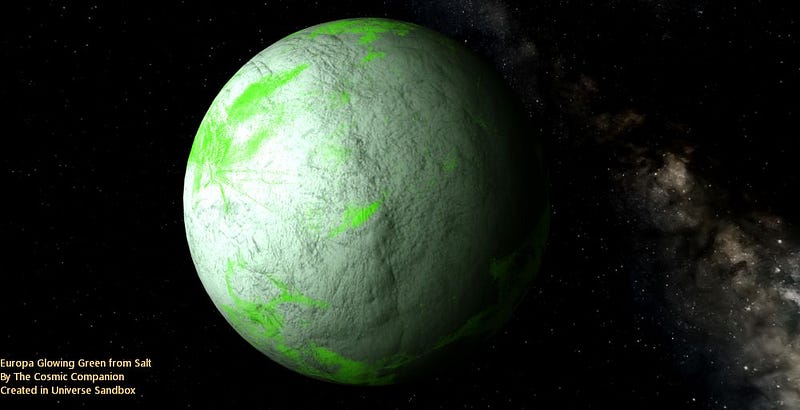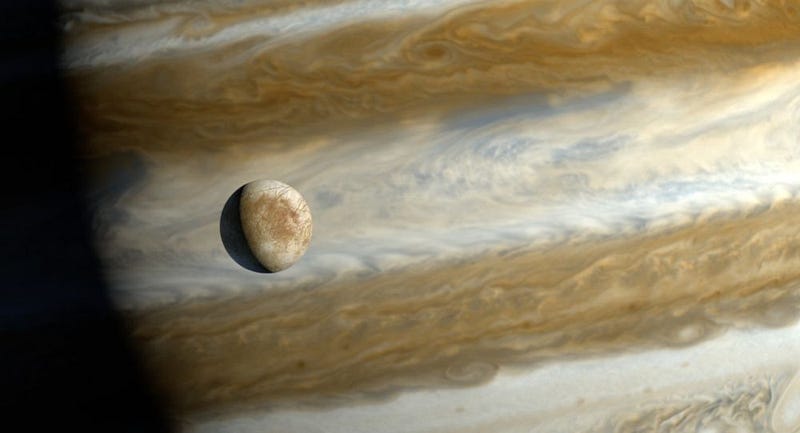Jupiter's Moon Europa: A Glowing Enigma in the Cosmos
Written on
The Glimmering Mystery of Europa
Recent astronomical findings have unveiled that Europa, one of Jupiter's prominent moons, emits a glow in the darkness, reminiscent of a celestial dance party.

An exaggerated artistic representation showcases Europa radiating a green hue due to salt crystals exposed to radiation. This green shade corresponds with the peak wavelengths identified in the latest research. Image credit: The Cosmic Companion / Created in Universe Sandbox.
Laboratory tests have successfully simulated Europa's surface, leading to a fascinating discovery — the moon shines in the dark. While we often observe the hemisphere of Europa facing Earth, this innovative study offers insight into the hidden aspects of this intriguing moon.
This revelation transcends mere trivia about our Solar System; it unlocks secrets about this mysterious celestial body.
Icy Composition of Europa
Europa's surface is laden with various salts, including magnesium sulfate (commonly known as Epsom salt) and sodium chloride (table salt). Each salt type emits distinct wavelengths of light when energy is released. The recent studies indicate that the salts in Europa's icy crust can illuminate in the dark.
As one of the Solar System's water-rich bodies, Europa conceals a massive ocean beneath its frozen exterior. According to NASA, “[E]uropa’s ice shell is 10 to 15 miles (15 to 25 kilometers) thick, floating on an ocean 40 to 100 miles (60 to 150 kilometers) deep. Consequently, despite its diameter being only a quarter that of Earth, Europa's ocean may hold twice the volume of all of Earth's oceans combined.”
The gravitational interplay between Europa, Jupiter, and its neighboring moons, Io and Ganymede, leads to fissures in the icy surface. In certain areas, the ocean percolates through these openings. Therefore, studying the surface can provide insights into Europa's concealed oceanic depths.
The Dance of Radiation

Radiation emitted by Jupiter elevates the energy levels of salt molecules as Europa navigates its orbit. When these molecules return to a stable state, the energy is released as visible light.
Researchers describe, “These high-energy charged particles, including electrons, interact with the ice- and salt-rich surface, resulting in complex physical and chemical processes,” as published in Nature Astronomy.
To the human eye, Europa's surface would radiate shades of green, blue, and white, contingent on the salt types emitting light. The strongest glow appears in green, akin to the common green screens utilized in film and video production, including broadcasts from Astronomy News with The Cosmic Companion.
Increased concentrations of Epsom salt led to a higher energy output, whereas sodium chloride and carbonate displayed the opposite effect.

The Europa Clipper, illustrated in this artistic conception, is set to be the first spacecraft to conduct detailed examinations of an extraterrestrial ocean. Image credit: NASA/JPL-Caltech.
As Europa orbits Jupiter, this diminutive moon, slightly smaller than our own, is subjected to intense radiation, including electrons. As these particles bombard the icy surface, the energy is emitted as light, resulting in Europa's eerie glow.
“If Europa were not exposed to this radiation, its appearance would mirror that of our moon — dark on the shadowed side,” stated Murthy Gudipati from Jet Propulsion Laboratory (JPL). “However, due to the radiation from Jupiter, it glows in the dark,” he elaborated.
The JPL team crafted a specialized instrument called the Ice Chamber for Europa’s High-Energy Electron and Radiation Environment Testing (ICE-HEART) to investigate how organic materials respond to radiation in a simulated environment akin to Europa's.
This revelation was an unexpected twist for the researchers. “Observing the sodium chloride brine with a notably reduced glow was the ‘aha’ moment that redirected our research trajectory,” commented Fred Bateman, a co-author of the study published in a scientific journal.
Exploring the Ocean World
“Man cannot discover new oceans unless he has the courage to lose sight of the shore.” — Andre Gide
NASA's Europa Clipper mission, slated for launch in the mid-2020s, aims to delve into the mysteries of this Jovian ocean world. The spacecraft will conduct multiple flybys, gathering detailed data about Europa's surface.
Investigators are meticulously assessing the instruments aboard to enhance the exploration of Europa's icy exterior. The Europa Clipper Wide Angle Camera is designed to capture extensive information about the salt concentrations present on the moon's surface.
Equipped with a 4k x 2k CMOS detector, this camera boasts a field of view of 48 by 24 degrees. From an altitude of 50 kilometers, it can discern details as minuscule as 11 meters, potentially revealing images of Europa's "night side," glowing in the dark.
While this study centers on Europa, its implications may extend to other large celestial bodies in high-radiation environments, including Io and Ganymede within the Jovian system.
Europa is considered one of the most promising locations in our solar system for potential life. The discovery of any life forms on Europa, regardless of their complexity, would suggest that life could emerge on other worlds throughout the Cosmos.
James Maynard, the founder and publisher of The Cosmic Companion, is a native New Englander who now resides in Tucson with his wife, Nicole, and their cat, Max.
Did you enjoy this article? Join us on The Cosmic Companion Network for our podcast, weekly video series, informative newsletter, news briefings on Amazon Alexa, and more!
The second video title is Europa Moon Glows In The Dark - YouTube, generates descriptions based on the title and insert descriptions then the video directive into the rst file.